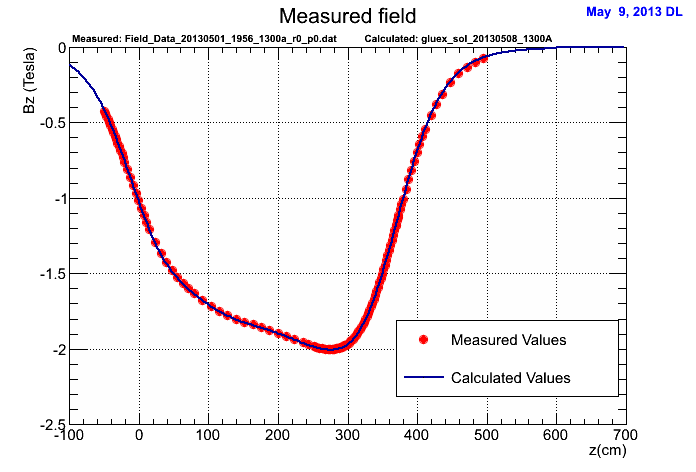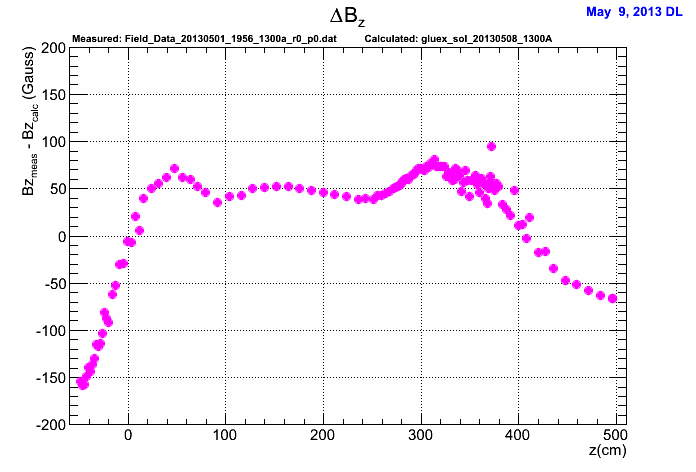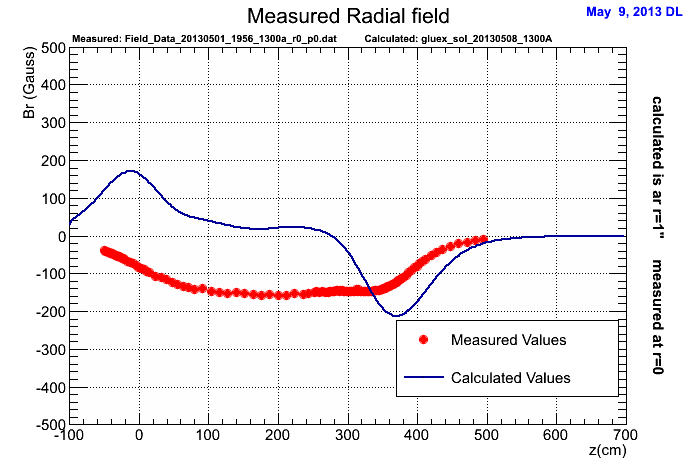Difference between revisions of "Solenoid Mapping Results: May 1, 2013"
(Created page with "On May 1st, 2013 an effort was made to map the solenoid. One set of points was taken along he z-axis at the center of the magnet (r=0) with 1300A of current. After that, the magn...") |
|||
| Line 20: | Line 20: | ||
Below are plots showing a comparison of the measured and calculated fields. Note that due to technical issues with the software, the calculated values correspond to r=1inch from the beam line while the measured values should be at r=0. | Below are plots showing a comparison of the measured and calculated fields. Note that due to technical issues with the software, the calculated values correspond to r=1inch from the beam line while the measured values should be at r=0. | ||
| + | |||
| + | Also, there is a z-shift of the measured z-values of -50.25 cm to align it with the lab system used by the calculated values. This was obtained empirically by zooming in to a plot of the measured and calculated values in the area of steepest gradient in Bz at around z=380cm. Adjusting this different by 0.25cm in either direction caused the discrepancy in Bz to increase slightly so I believe we are within 0.25cm of the true offset. | ||
[[File:bfield_compare_20130509.png]] | [[File:bfield_compare_20130509.png]] | ||
| − | [[File:bfield_zdiff_20130509.png]] | + | [[File:bfield_zdiff_20130509.png|This estimates the difference between the measured and calculated fields. It does this by creating a 3rd order spline from the calculated values and then evaluating the spline at the measured z-values.]] |
| − | [[File:bfield_Br_20130509.png]] | + | [[File:bfield_Br_20130509.png|This plot of the radial component of the field may be a bit misleading. In the ideal case, the radial component will be zero if perfectly on the axis of symmetry. The calculated values though are slightly off that, so the curve shows the expected behavior of having the radial components larger at the edges of the magnet and in opposite directions on the two ends. The measured values should in principle be zero everywhere, but show a 150Gauss offset in the center of the magnet(??)]] |
Revision as of 08:33, 9 May 2013
On May 1st, 2013 an effort was made to map the solenoid. One set of points was taken along he z-axis at the center of the magnet (r=0) with 1300A of current. After that, the magnet quenched as it was being ramped up to 1500A do to the full mapping. Below are plots comparing the one data set obtained from mapping to a Poisson calculation of the field at 1300A.
The configuration files used for the Poisson calculation can be found in the subversion repository here:
https://halldsvn.jlab.org/repos/trunk/home/davidl/PoissonConfigFiles
The relevant files are:
gluex_sol_20130508_1300A.am gluex_sol_20130508_1300A.in7 gluex_sol_20130508_1300A.xlsx
The source code, binaries, and instructions on calculating the field can also be found in the subversion repository here:
https://halldsvn.jlab.org/repos/trunk/sim-recon/src/programs/Utilities/bfield_poisson
The data file containing the measured values is:
/group/halld-online/Solenoid_Mapping/Field_Data_20130501_1956_1300a_r0_p0.dat
Below are plots showing a comparison of the measured and calculated fields. Note that due to technical issues with the software, the calculated values correspond to r=1inch from the beam line while the measured values should be at r=0.
Also, there is a z-shift of the measured z-values of -50.25 cm to align it with the lab system used by the calculated values. This was obtained empirically by zooming in to a plot of the measured and calculated values in the area of steepest gradient in Bz at around z=380cm. Adjusting this different by 0.25cm in either direction caused the discrepancy in Bz to increase slightly so I believe we are within 0.25cm of the true offset.


